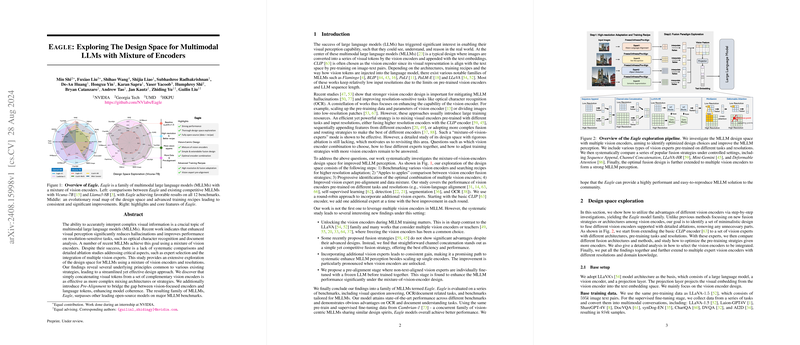Exploring the Design Space for Multimodal LLMs with Mixture of Encoders
The paper "Eagle: Exploring The Design Space for Multimodal LLMs with Mixture of Encoders" presents an extensive investigation into enhancing Multimodal LLMs (MLLMs) through the integration of multiple vision encoders. By systematically analyzing the design space and implementing a novel approach to combining vision encoders, the authors propose the Eagle framework, which exhibits significant improvements in performance across various benchmarks.
Core Contributions
The central contributions of the paper are as follows:
- Benchmarking and Ablation Studies: The authors perform rigorous benchmarking and ablation studies to compare various vision encoder fusion strategies. The paper reveals that straightforward methods like simple concatenation of visual tokens often outperform more complex fusion schemes.
- Pre-Alignment Strategy: A pre-alignment training stage is proposed to integrate multiple vision experts effectively. This stage aligns the representation from each encoder with the LLM, bridging the gap between vision-focused encoders and language tokens, and significantly enhancing model coherence.
- Systematic Exploration: The research entails a detailed exploration of the design space, investigating the optimal combination of vision encoders and evaluating the impact of different training strategies. This leads to the formulation of optimized training recipes for achieving superior performance across various tasks.
- Empirical Validation: Comprehensive experiments demonstrate that integrating more vision experts, with optimized training recipes, consistently improves the model's performance. Eagle surpasses leading open-source models on major MLLM benchmarks, particularly in tasks requiring high-resolution visual detail and multimodal understanding.
Methodology and Experimental Setup
Vision Encoders and Training Strategy
The authors benchmark various vision encoders, including CLIP, ConvNeXt, EVA-02, Pix2Struct, SAM, and DINOv2, pre-trained on diverse tasks such as image-text alignment, object detection, text recognition, and segmentation. The research investigates high-resolution adaptation, concluding that unlocking and fine-tuning vision encoders during training significantly enhances performance without the need for complex input tiling mechanisms.
Fusion Strategy
Different fusion strategies, including Sequence Append, Channel Concatenation, and LLaVA-HR, are evaluated. Channel Concatenation emerges as the most effective and efficient method, leading to the optimal design choice for integrating multiple vision encoders.
Pre-Alignment
The pre-alignment strategy involves training each pre-trained vision expert individually with the same LLM. This bridges the gap between diverse vision encoders and enables better integration during subsequent joint training stages. The experiments validate that this approach mitigates inconsistencies among vision experts, resulting in significant performance gains.
Multi-Expert Integration
A step-by-step greedy strategy is employed to incorporate additional vision experts, revealing that combining diverse encoders consistently improves the model's performance. This iterative process determines the optimal set of vision encoders for Eagle, leading to a robust and efficient MLLM architecture.
Results and Implications
Eagle is benchmarked across various tasks, including visual question answering (VQA), OCR and document understanding, and comprehensive multimodal benchmarks. The results highlight Eagle’s superior performance:
- VQA Tasks: Eagle achieves state-of-the-art results on GQA and VQAv2, underscoring the advantages of the mixture-of-encoders approach.
- OCR and Document Understanding: Eagle significantly outperforms competitors on TextVQA and OCRBench, attributed to its high-resolution architecture and diverse vision encoders.
- Multimodal Benchmarks: Consistent improvements are observed on benchmarks like MME, MMBench, and SEED, demonstrating Eagle’s robust generalization capabilities.
Practical and Theoretical Implications
The research provides practical guidelines for designing MLLMs with multiple vision encoders, emphasizing the importance of systematic design choices over complex architectural innovations. The results suggest that enhancing visual perception through effective integration and training of diverse vision encoders can substantially elevate the capabilities of MLLMs, particularly in resolution-sensitive tasks.
Future Directions
Future research could explore the integration of additional vision tasks and further refinement of training strategies. Combining the mixture-of-encoders approach with advanced tiling techniques may yield even more powerful models. Moreover, extending the methodology to even larger LLMs could unlock new potentials in MLLM capabilities.
In conclusion, the paper presents a thorough analysis and novel contributions to the field of MLLMs, demonstrated through the significant performance improvements of the Eagle framework. This paper sets a new benchmark for future research and development in multimodal AI.
